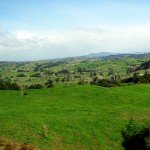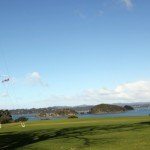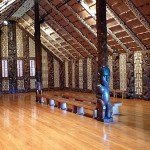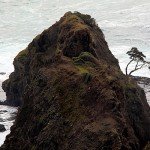Monday: Auckland to Paihia
On Monday morning, as the big polar storm was making its way deep into New Zealand, Natalie and I headed to Britomart (Central Transport Centre for buses and trains) in downtown Auckland to pick up our bus to get to the North. A couple minutes before 8am, our jet black NakedBus arrived and Mike, our driver loaded the 7 of us and our baggage making the trip onto the coach and we headed out of Auckland.
 NakedBus, contrary to what its name might conjure is very much like Greyhound in the United States. It is a national bus network connecting nearly everywhere you want to go with wherever you may be. The name NakedBus really just seems to go along with their tagline “Stripping the price of NZ bus travel”. We had a great trip at a very inexpensive price on a clean coach with free Wifi (as long as the mobile signal permitted).
NakedBus, contrary to what its name might conjure is very much like Greyhound in the United States. It is a national bus network connecting nearly everywhere you want to go with wherever you may be. The name NakedBus really just seems to go along with their tagline “Stripping the price of NZ bus travel”. We had a great trip at a very inexpensive price on a clean coach with free Wifi (as long as the mobile signal permitted).
As we made our way out of central Auckland, we crossed the Auckland Harbour Bridge (yet another object in New Zealand you can bungy off of if you wish), and almost immediately the amazing beauty of the New Zealand countryside made itself apparent.  For nearly 4 hours, as we continued north on SH1 (State Highway 1) we just stared in awe at the endless rolling green hills, farms, trees, animals (lots of dairy, beef, and sheep farms in this region) and the occasional home that dotted the landscape. Just to add to the picture postcard view were light strands of fog and the occasional rain shower as it rolled over the peaks and into the valleys as we made our way up the two lane road towards our destination, Paihia.
For nearly 4 hours, as we continued north on SH1 (State Highway 1) we just stared in awe at the endless rolling green hills, farms, trees, animals (lots of dairy, beef, and sheep farms in this region) and the occasional home that dotted the landscape. Just to add to the picture postcard view were light strands of fog and the occasional rain shower as it rolled over the peaks and into the valleys as we made our way up the two lane road towards our destination, Paihia.
After a short stop for morning tea and toilets at a small cafe about midway through the trip, we continued north and turned off east onto SH10 towards the Bay of Islands at Kawakawa. The Bay, as with most areas in New Zealand, is made up of volcanic activity from thousands of years ago, leaving a collection of islands, small and large throughout the region. Most are uninhabited, with a majority of the people concentrated along the coastline in Paihia, Russell, and Kerikeri. Our first stop of the day in the Bay was the location of the Treaty of Waitangi signed in 1840, which granted sovereign rights to the Maori people.
 Waitangi is located a short 20 minute walk north of Paihia, along the waterfront edge. The land trust for Waitangi was granted to the northern Maori tribe to develop this into a historical place of interest for all people to visit and to gain knowledge about the great history that took place here.
Waitangi is located a short 20 minute walk north of Paihia, along the waterfront edge. The land trust for Waitangi was granted to the northern Maori tribe to develop this into a historical place of interest for all people to visit and to gain knowledge about the great history that took place here.
In the 17th century, the Dutchman, Abel Tasman was the first to lay eyes on New Zealand, though he never actually came onto the land. It wasn’t until later when Captain Cook landed that began the eventual influx of Europeans to the country in the late 18th century. During all of this initial exploration, the native Maori people had a very impressive and intricate society made up of a number of tribes all over the country, each with its own collective leadership and communities.
As the arriving Europeans began to swell in size, number, and desire to become land owners grew, the Maori began to feel the impacts of it, and through the official British representative, James Busby, the tribes collectively sent a request to the British Monarchy asking to take responsibility for the growing lawlessness and reckless actions of the incoming residents. Sure enough, the British sent along a Navy Officer, Hobson, who arrived and worked with the local Maori chiefs and Busby to develop the framework of the 1840 Waitangi Treaty in early February of that year, granting sovereign rights to the Maori, along with rules on land ownership, and the development of the first National flag of New Zealand (still in use today at the United Nations, along with the current flag we all know today).
At the Waitangi Treaty Grounds, the site is visually stunning with endless green lawns running in all directions, along with native trees lining the boundaries of the park as the pathways winding through the park make their way to the water’s edge at Hobson’s beach (named after the British Naval Officer mentioned above). Upon arrival, we enjoyed a quick picnic lunch outside as we admired the site and then headed into the Visitor Centre for a Maori cultural performance. All of the performers and tour guides on the Waitangi site are direct descendents of the original Maori participants at the Treaty, and as the Maori are an oral tradition people (until very recently, nothing was written and all passed down via adult to child through stories, song, dance, and chants), it was very exciting to watch and speak with all of these people as their appreciation for this place was so visible in their actions and their sharing of their culture and tradition.
 “Kia Ora! Kia Ora! Kia Ora! We welcome you once, we welcome you twice, we welcome you three times!” The young Maori woman, probably a couple years younger than us came outside of the performance room and introduced herself and walked us through the welcome ceremony that we would participate in. As we were lead inside to the intimate theatre (seating for no more than 50). As we took our seats the performance troupe of 3 began a beautiful display of Maori singing, chants, and the warrior welcome speech to officially welcome us to this sacred place to the Maori people.
“Kia Ora! Kia Ora! Kia Ora! We welcome you once, we welcome you twice, we welcome you three times!” The young Maori woman, probably a couple years younger than us came outside of the performance room and introduced herself and walked us through the welcome ceremony that we would participate in. As we were lead inside to the intimate theatre (seating for no more than 50). As we took our seats the performance troupe of 3 began a beautiful display of Maori singing, chants, and the warrior welcome speech to officially welcome us to this sacred place to the Maori people.
It was about this point that the reality of the situation hit us. We were the only 2 people in the audience. Maybe it was the cold weather, the intermittent rain showers, or the fact that we chose to watch the performance in the afternoon, versus at the start of the day, but we got to enjoy this 30 minute collection of song, dance, music, and display all to ourselves. The performance troupe were amazing and presented their talents as if they were performing for 200, let alone 2, and we were so appreciative of the opportunity to view this show.
As fortunate as we were to see the show in such an intimate setting, payback came a few short minutes later as the troupe announced that audience participation time had come. Natalie was provided a private lesson in the Poi, and Darin got to learn the warrior dance and display of the Haka. It was fun, and the performers were incredibly great sports, given the size of the audience…
 Following the end of the performance, we made our way out of the theatre and met up with our tour guide for a walk of the grounds. Again, for reasons we can only attribute to pure luck, we were on this tour solo with the guide. He, too, was a direct descendent of the Waitangi treaty signers and shared a wealth of knowledge with us as we saw the Treaty House, a traditional Maori meeting house erected on the site, and got to see a huge waka or traditional Maori canoe, fashioned from 3 separate trees lashed together in traditional fashion. At over 100 feet (35m) long, it is the longest in the world, and is put out into the bay once a year on Waitangi Day in February to commemorate the signing of the treaty.
Following the end of the performance, we made our way out of the theatre and met up with our tour guide for a walk of the grounds. Again, for reasons we can only attribute to pure luck, we were on this tour solo with the guide. He, too, was a direct descendent of the Waitangi treaty signers and shared a wealth of knowledge with us as we saw the Treaty House, a traditional Maori meeting house erected on the site, and got to see a huge waka or traditional Maori canoe, fashioned from 3 separate trees lashed together in traditional fashion. At over 100 feet (35m) long, it is the longest in the world, and is put out into the bay once a year on Waitangi Day in February to commemorate the signing of the treaty.
Another amazing day, one that we weren’t expecting given the weather, some changes of plans, etc. and yet we are finding that things just seem to fall into place.
Tuesday: Cape Reinga, Sandboarding, 90 Mile Drive
Another early start this morning, as our coach for the day picked us up from our motel in Paihia at 7:15am for a full day tour of the Northland of New Zealand. Fullers Great Sights was our provider for the day, and Derek, our driver and guide put his 1000+ trips of experience into play making for a memorable day that won’t be forgotten anytime soon.
The key to this trip is the timing of the tides as 90 mile drive is keenly dependent on this. Today’s tides meant that we would be completing our itinerary for the day in reverse, but this had little impact on the enjoyment of the day.
 We began our day in the Manginangina Scenic Preserve, home to a dwindling number of native New Zealand kauri trees. So many of these massive trees were harvested for use in building, both here in New Zealand as well as for export that their numbers are limited. This section of the forest is protected under the Department of Conservation and a boardwalk walkway has been built in the forest to walk amongst these Kiwi giants, that can only be described as a “pale cousin” to giant Redwood trees on the California pacific coast. They are absolutely massive towering over the surrounding trees at well over 100 feet high (35m) and require several folks joining hands to make it around the circumference of the huge trunks.
We began our day in the Manginangina Scenic Preserve, home to a dwindling number of native New Zealand kauri trees. So many of these massive trees were harvested for use in building, both here in New Zealand as well as for export that their numbers are limited. This section of the forest is protected under the Department of Conservation and a boardwalk walkway has been built in the forest to walk amongst these Kiwi giants, that can only be described as a “pale cousin” to giant Redwood trees on the California pacific coast. They are absolutely massive towering over the surrounding trees at well over 100 feet high (35m) and require several folks joining hands to make it around the circumference of the huge trunks.
 After a short walk into the forest, we returned to the coach and continued north towards Cape Reinga, the northern most point of New Zealand, the point where the Pacific Ocean and the Tasman sea come together, and considered one of the most sacred places in the Maori tradition. The Maori believe that this is the place that spirits come to depart the land of the living and join the other spirits of their ancestors. Today, the site is home to a single lighthouse, otherwise there is a walking path to allow visitors to wind their way to the Point, taking in breathtaking seascapes as the weather constantly churned from blue sky and partly cloudy to blowing rain and a frigid wind chill, all in the span for 45 minutes. There is a striking rock outcropping with a single tree on it. The Maori believe this is the entry/exit point for the spirits and given the beauty of this place, I can understand why it is so revered.
After a short walk into the forest, we returned to the coach and continued north towards Cape Reinga, the northern most point of New Zealand, the point where the Pacific Ocean and the Tasman sea come together, and considered one of the most sacred places in the Maori tradition. The Maori believe that this is the place that spirits come to depart the land of the living and join the other spirits of their ancestors. Today, the site is home to a single lighthouse, otherwise there is a walking path to allow visitors to wind their way to the Point, taking in breathtaking seascapes as the weather constantly churned from blue sky and partly cloudy to blowing rain and a frigid wind chill, all in the span for 45 minutes. There is a striking rock outcropping with a single tree on it. The Maori believe this is the entry/exit point for the spirits and given the beauty of this place, I can understand why it is so revered.
From here, we made our way into a protected bay called Tapotupotu to have a picnic lunch at picnic tables just yards from the beach as the gulls sat peacefully and watched the visitors to their home.
 Leaving Tapotupotu at 1pm in the afternoon, we began to work our way to the west, towards the Tasman Sea and to Te Paki, the location of the massive sand dunes that rise to nearly 500 feet (165m) in height. As they began to grow larger and larger in size as we drew closer, Derek began prepping us for what was to come. In just a few minutes, we were going to sandboard down these monsters. No shoes are permitted on the dunes, so they and the socks were taken off. Next, we should be prepared for sand to get everywhere, so pockets were emptied, pant legs rolled up, and jackets were zipped up tight, closing off any entry points for sand. Once the bus got into position, all participants for the dunes jumped off the bus, picked up our sandboards (think boogie board with a slick plastic underside) from the undercarriage of the bus, received some final instructions from Derek, and we were trekking up the dunes to our start point.
Leaving Tapotupotu at 1pm in the afternoon, we began to work our way to the west, towards the Tasman Sea and to Te Paki, the location of the massive sand dunes that rise to nearly 500 feet (165m) in height. As they began to grow larger and larger in size as we drew closer, Derek began prepping us for what was to come. In just a few minutes, we were going to sandboard down these monsters. No shoes are permitted on the dunes, so they and the socks were taken off. Next, we should be prepared for sand to get everywhere, so pockets were emptied, pant legs rolled up, and jackets were zipped up tight, closing off any entry points for sand. Once the bus got into position, all participants for the dunes jumped off the bus, picked up our sandboards (think boogie board with a slick plastic underside) from the undercarriage of the bus, received some final instructions from Derek, and we were trekking up the dunes to our start point.
Unfortunately, there is no ski lift to the top — it is all foot power in thick, but comfortable, sand the consistency of brown sugar. The climb to the top was tiring, but the view from the top was worth it. Here, Derek helped to get everyone into position and take their first ride down. Instructions are pretty simple. He holds your board in place, you drop to your knees, grab the front of the board, lay on your belly, keep your elbows in at all times, and use your toes as your brakes. Once you are in position, gravity takes over and the next 8 seconds are pure adrenaline as you fly down the steep slope toward the stream of water at the bottom.
 The rider has one of two options to consider — 1) Stop before the stream or 2) Maintain enough speed to skip yourself across the stream, like skipping a rock across a pond and make it to the other side. Most folks did well at option 1, including both Natalie and I. One or two hearty souls pulled off option 2. And of course there was at least a few folks that somehow invented option 3) Splashdown in the center of the stream, soaking themselves to the bone. Given that temps were in the 50s (around 10 degrees C), we were just fortunate to miss the water. The sandboarding was great fun and Darin hiked himself up to the top for a second run.
The rider has one of two options to consider — 1) Stop before the stream or 2) Maintain enough speed to skip yourself across the stream, like skipping a rock across a pond and make it to the other side. Most folks did well at option 1, including both Natalie and I. One or two hearty souls pulled off option 2. And of course there was at least a few folks that somehow invented option 3) Splashdown in the center of the stream, soaking themselves to the bone. Given that temps were in the 50s (around 10 degrees C), we were just fortunate to miss the water. The sandboarding was great fun and Darin hiked himself up to the top for a second run.
After a fun experience at the Te Paki sand dunes, we all claimed back onto the bus, and it continued a few more kms west and we said goodbye to the road for the next hour or so as we drove onto one of the most unique highways in the world — 90 Mile Drive. This official state highway of New Zealand has a speed limit, police patrols, but it is on the beach. Our bus reached speeds of over 100kph (60 miles an hour) as the waves crashed just feet from the bus, providing us a truly unique experience to see the west coastline of north New Zealand.
 We were making good time, so we got to make two stops along the way, get out of the bus on the beach, and walk around, seeing seashell covered bluffs, rock formations and islands out in the surf, birds and more. Our driver, Derek, did an exceptional job as he explained the rules of driving on a beach — 1) Don’t stop anywhere you might sink into the sand, 2) Sand is not as soft as you might think it is… There are bumps and avoiding them provides a much more comfortable trip, and 3) Sometimes you need to run counter to your instincts and driving through a wave is not the worst thing in the world. Driving through the crashing waves from the Tasman Sea as the bus windows got soaked was amazing and an experience to remember.
We were making good time, so we got to make two stops along the way, get out of the bus on the beach, and walk around, seeing seashell covered bluffs, rock formations and islands out in the surf, birds and more. Our driver, Derek, did an exceptional job as he explained the rules of driving on a beach — 1) Don’t stop anywhere you might sink into the sand, 2) Sand is not as soft as you might think it is… There are bumps and avoiding them provides a much more comfortable trip, and 3) Sometimes you need to run counter to your instincts and driving through a wave is not the worst thing in the world. Driving through the crashing waves from the Tasman Sea as the bus windows got soaked was amazing and an experience to remember.
 One final stop on our way home was to pickup some freshly made fish and chips from the Mangonui Fish shop. Traditional fish and chips served in paper wrapped parcels contained a huge battered and fried piece of the fresh fish of the day, Hapuku, along with a huge mound of hand cut chips. We all picked them up and jumped back on the bus “to go” style and ate as we made our way back to Paihia to close out the day.
One final stop on our way home was to pickup some freshly made fish and chips from the Mangonui Fish shop. Traditional fish and chips served in paper wrapped parcels contained a huge battered and fried piece of the fresh fish of the day, Hapuku, along with a huge mound of hand cut chips. We all picked them up and jumped back on the bus “to go” style and ate as we made our way back to Paihia to close out the day.
We arrived back into Paihia at 5:37pm — Our bus driver Derek was a bit uncanny with his ability to make predictions throughout the day (“its going to rain while you are here”, even though there were blue skies, and nailed our return time to the minute), so he deserves bonus points on a great day as our driver and guide to the amazing Northland of New Zealand.
Yes, it was cold, but thanks to amazing Kiwi hospitality from our driver and guide, and plenty of fun from our fellow passengers onboard the Great Sights bus, it was a great day to Cape Reinga, Te Paki sand dunes, and along 90 Mile Drive.
As always, we’re posting even more photos at the Photo Gallery. Check them out to see full size pics and the slideshow!
Question: What is one thing you would like to know more about from the trip? Some of the deals we’ve been able to snag along the way to keep costs down? What our meals are looking like on the road? Your input is always appreciated… Let us know!



Leave a reply